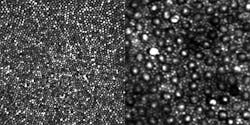BIOPHOTONICS: Invited talks highlight major biomedical optics themes at Frontiers in Optics 2012
Each year, the Frontiers in Optics (FiO) meeting (Rochester, NY; October 14–18, 2012) reports R&D advances across multiple disciplines—and biomedical optics is a perennial favorite. Among the several motifs in life sciences talks this year is adaptive optics: Plenary speaker David R. Williams of the University of Rochester will describe use of the technique—which is used to compensate for aberrations in imaging systems—for imaging single cells in the living retina. Dr. Williams has pioneered application of this approach to correct for the limitations of the eye’s own imaging system, enabling microscopic views with unprecedented resolution (see figure).
The rest of the retinal imaging field has begun to follow this lead, with adaptive optics reaching a critical mass this year. In fact, a dedicated theme of the conference, “Adaptive Optics for Vision and Imaging,” is sponsored jointly by the meeting’s Optical Design, Fabrication, and Instrumentation and the Vision and Color program subcommittees: It features such luminaries as Pablo Artal from University of Murcia (Spain) and Jason Porter from the University of Houston, College of Optometry.
Invited speakers will discuss the use of adaptive optics in other life sciences areas, too: Martin Booth from Oxford University in England will speak on their use for high-resolution microscopy, while Myung K. Kim from University of South Florida will cover application to digital holography, and Juan M. Bueno of the University of Murcia will discuss the use of adaptive optics to improve second-harmonic generation imaging of corneal structure.
Another timely theme, “Biophotonics and Optofluidics for Point-of-Care and Global Health Applications,” will explore platforms that can provide immediate results wherever a medical procedure occurs instead of at a remote laboratory. For instance, Stephen Boppart of the University of Illinois at Urbana-Champaign (UIUC) who will speak on using optical coherence tomography (OCT) in primary care, and Holger Schmidt of the University of California – Santa Cruz will speak on using optofluidics for molecular diagnostics.
Microscopy and OCT research has had a strong presence at FiO recently; this year will discuss applications to neuroscience, with Elizabeth Hillman of Columbia University and Chris Xu of Cornell both exploring imaging of the living brain. Those covering microscopy advances include Jeff Squier of the Colorado School of Mines discussing multiphoton microscopy, and Gabriel Popescu of UIUC and Jerome Mertz of Boston University presenting novel phase microscopy methods. Featured OCT researchers include Zhongping Chen of University of California – Irvine explaining intravascular applications, and David Huang of the Casey Eye Institute detailing application to corneal imaging.
FiO 2012 will highlight valuable developments in many areas, as well as research discussions affecting the larger bio community. Information sharing and networking are key goals of the conference, which after 96 years running, is not to be missed!—Adam Wax, Program Chair, FiO 2012

